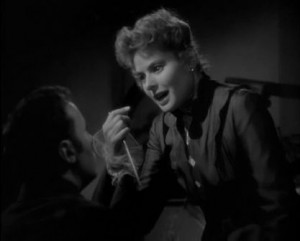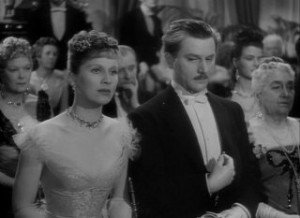 The presumed climax of the film, of course, is when Paula confronts for the last time her arrested and bound husband. He asks her to find a knife in a drawer and cut him free. There is the allusion to (or is it a parody of?) Lady Macbeth’s line in Act I, scene 7, of Shakespeare’s famous “Scottish” play: “Is this a dagger I see before me . . . ?” Paula’s version is “Are you suggesting this is a knife I hold in my hand?” All well and good, this grand soliloquy. Certainly one reason, maybe the clincher, for Ingrid’s Oscar.
The presumed climax of the film, of course, is when Paula confronts for the last time her arrested and bound husband. He asks her to find a knife in a drawer and cut him free. There is the allusion to (or is it a parody of?) Lady Macbeth’s line in Act I, scene 7, of Shakespeare’s famous “Scottish” play: “Is this a dagger I see before me . . . ?” Paula’s version is “Are you suggesting this is a knife I hold in my hand?” All well and good, this grand soliloquy. Certainly one reason, maybe the clincher, for Ingrid’s Oscar.
For me, however, the highlight of the film is the dénouement, the detective’s lengthy scene with the wife. All is revealed to the naïve Paula, information the viewer already knows or has long ago suspected.
On a night when both Gregory and Nancy leave the house, Cameron convinces Elizabeth to let him in—for the sake of her mistress’s well-being. He gains Paula’s trust by showing her the glove Alice Alquist had given him, a glove Paula matches with one in her china cabinet. “She gave it to you?” she asks gently. “After all these years, the great admirer she used to make such a mystery of—a little boy!” Her acting here is wonderfully soft and subdued, and totally convincing in its suggested spontaneity, the way she caresses the single glove, a mere prop though it may be.
Then Cameron notices something. “The gas just went down.”
“You saw that, too!” she says.
“Why, yes.”
“Oh! Then it really happens. I thought I had imagined it.”“But it only means that someone else has turned it on.”
“Oh, no, no. I thought that, too. But every night I’ve been all over the house and there’s never been another light turned on. . . . There have been nights when my husband goes out—”
“—the light goes down—”
After a long pause, she says vaguely, “Yes—”
“And then what?”
“Well, then—I think I hear things. I watch. I wait. Later on, the gas goes up again.”
“—and he comes back.”
“Yes—quite soon after, always quite soon after.”
“You say you think you hear things,” he says. “What kind of things?”
“Sounds. Noises over my room.”
Cameron walks upstairs.
“What’s up there?”
“A whole floor of trunks and furniture.” (All of Alice Alquist’s “things,” which Gregory had urged his wife to store in the attic.)There’s a bump from the ceiling.
“Is that what you meant?” Cameron asks.
“Yes, yes, yes—but who?”
“Mrs. Anton, you know, don’t you? You know who’s up there.”
“No, no.”
“You sure you don’t?”
“No, no—how could he be?”
“There’s an alley behind these houses. He goes in the back of No. 5—that’s the empty one—and then across the roof.”
“Why? Why?”
Later he tells her, “You’re not going out of your mind. You’re slowly and systematically being driven out of your mind.”
 Most of the names in the British version of Gaslight of four years earlier were changed by M-G-M in its remake, perhaps trying to obliterate its memory, including rumored attempts to destroy all existing prints. Even the address, No. 9 Thornton Square, is new, along with the characters’ names, although one, the maid Nancy (played by Cathleen Cordell), is retained. Anton Walbrook is a bit more theatrical in the Boyer role, Diana Wynyard less hysterical than Ingrid and Frank Pettingell the antithesis of the handsome Cotton. The rotund, middle-aged Pettingell imparts to his role a super self-confidence and an instant screen likeability, though he is hardly a romantic lead—and there is no attempt at such. Another plus for the 1940 version is the presence, at least, of Robert Newton, a character dropped in the 1944 script, rightly so as his short part is essentially wasted. As a cousin of the lady in distress, his help is enlisted by Pettingell.
Most of the names in the British version of Gaslight of four years earlier were changed by M-G-M in its remake, perhaps trying to obliterate its memory, including rumored attempts to destroy all existing prints. Even the address, No. 9 Thornton Square, is new, along with the characters’ names, although one, the maid Nancy (played by Cathleen Cordell), is retained. Anton Walbrook is a bit more theatrical in the Boyer role, Diana Wynyard less hysterical than Ingrid and Frank Pettingell the antithesis of the handsome Cotton. The rotund, middle-aged Pettingell imparts to his role a super self-confidence and an instant screen likeability, though he is hardly a romantic lead—and there is no attempt at such. Another plus for the 1940 version is the presence, at least, of Robert Newton, a character dropped in the 1944 script, rightly so as his short part is essentially wasted. As a cousin of the lady in distress, his help is enlisted by Pettingell.
A viewing of the 1940 British Gaslight prompts two immediate, undeniable impressions: first, M-G-M movie-makers, clearly director and screenwriters, must have known the original well or at least previewed it diligently, for the similarities are striking; and, second, Pettingell, for my money, is the standout in his movie and, I have to admit, creates a character far more multifaceted and interesting than Cotton’s.
 Leonard Maltin implies that the British Gaslight is superior “in [its] electrifying atmosphere, delicious performances and a succinctly conveyed sense of madness and evil lurking beneath the surface of the ordinary.” But to assuage any hint that I prefer the 1940 version, who could be more sinister than Charles Boyer in his understated portrayal, a romantic lead cast against type? Those looks in his eyes imply he is the crazy one. As he admits to Paula before the police take him away, it was the thought of those jewels that were like “a fire in my brain.”
Leonard Maltin implies that the British Gaslight is superior “in [its] electrifying atmosphere, delicious performances and a succinctly conveyed sense of madness and evil lurking beneath the surface of the ordinary.” But to assuage any hint that I prefer the 1940 version, who could be more sinister than Charles Boyer in his understated portrayal, a romantic lead cast against type? Those looks in his eyes imply he is the crazy one. As he admits to Paula before the police take him away, it was the thought of those jewels that were like “a fire in my brain.”